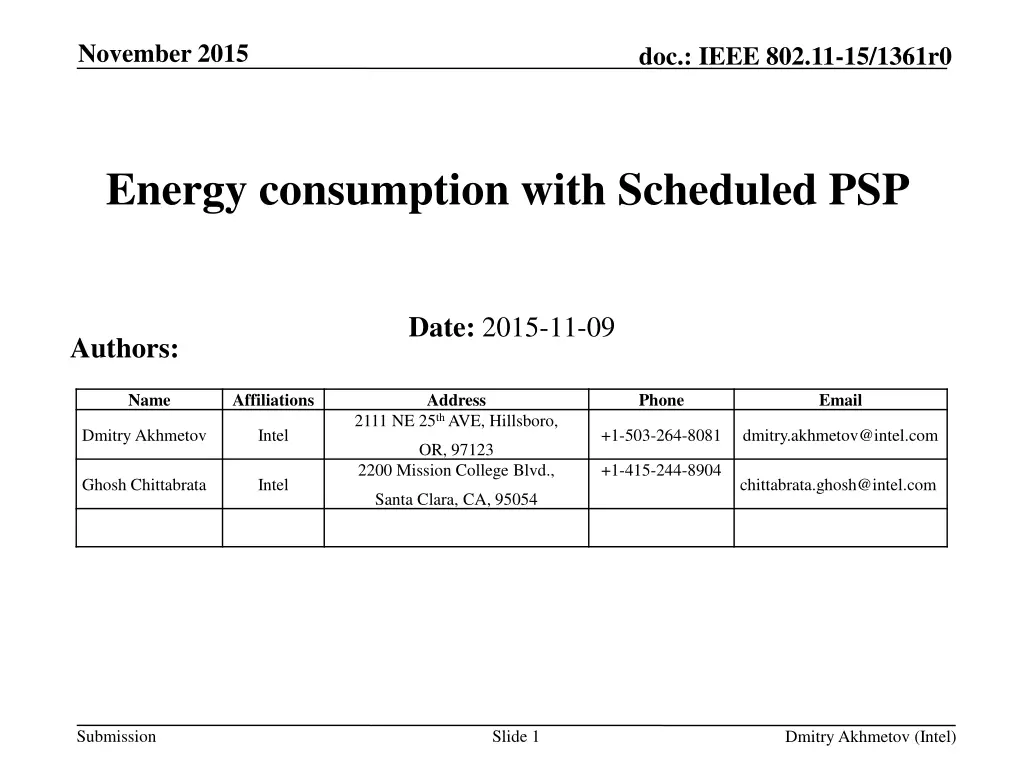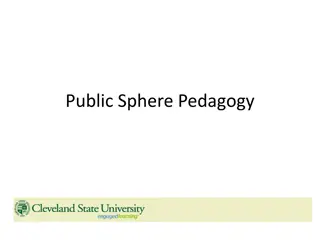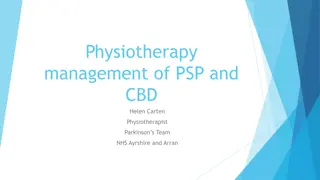
Reduced Energy Consumption in IEEE 802.11-15/1361r0 Document
This document discusses energy consumption comparisons for Scheduled Partially-Stationary Pattern (PSP) with Regular PSP in the context of IEEE 802.11-15/1361r0. It includes simulation results on energy consumption, the impact on Listen/Receive states, and time spent in Shallow sleep state. Additionally, it introduces the concept of Target Transmission Time (TTT) for power save STAs to enhance energy efficiency and BSS performance.
Download Presentation

Please find below an Image/Link to download the presentation.
The content on the website is provided AS IS for your information and personal use only. It may not be sold, licensed, or shared on other websites without obtaining consent from the author. If you encounter any issues during the download, it is possible that the publisher has removed the file from their server.
You are allowed to download the files provided on this website for personal or commercial use, subject to the condition that they are used lawfully. All files are the property of their respective owners.
The content on the website is provided AS IS for your information and personal use only. It may not be sold, licensed, or shared on other websites without obtaining consent from the author.
E N D
Presentation Transcript
November 2015 doc.: IEEE 802.11-15/1361r0 Energy consumption with Scheduled PSP Date: 2015-11-09 Authors: Name Affiliations Address Phone Email 2111 NE 25th AVE, Hillsboro, Dmitry Akhmetov Intel +1-503-264-8081 dmitry.akhmetov@intel.com OR, 97123 2200 Mission College Blvd., +1-415-244-8904 Ghosh Chittabrata Intel chittabrata.ghosh@intel.com Santa Clara, CA, 95054 Submission Slide 1 Dmitry Akhmetov (Intel)
November 2015 doc.: IEEE 802.11-15/1361r0 Abstract This presentation provides simulation results on energy consumption for Scheduled PSP in comparison with regular PSP Quantify the reduced energy consumption in Listen/Receive states and increased time in Shallow sleep state Submission Slide 2 Dmitry Akhmetov, Intel
November 2015 doc.: IEEE 802.11-15/1361r0 PSP STA wakes every DTIM to check if it has any data in DL If TIM bit is set STA transmits PS-Poll frame to indicate it s presence to an AP STA remains in active state until it receive DATA from an AP AP access the medium and transmit data in DL followed by an ACK frame from a STA STA enters Sleep state DL DL Beacon Beacon A C K A C K AP DATA 1 DATA 2 AP contention AP contention SIFS SIFS A C K PS POLL STA 1 contention SIFS S L E E P S L E E P Enter sleep wake wake PS POLL A C K STA 2 cntn contention contention SIFS S L E E P S L E E P wake wake Enter sleep Submission Slide 3 Dmitry Akhmetov, Intel
November 2015 doc.: IEEE 802.11-15/1361r0 PSP using Target transmission time In September meeting in 15/1107r0 a concept of target transmission time for TF-R was introduced SFD 15/0132r09 states: The spec shall include a mechanism that allows the Beacon frame to indicate the target transmission time(s) of one or more Trigger frame(s) that allocate resources for random access. Target Transmission Times(s) (TTT) can be used by power save STAs for increased energy efficiency Power saving through decreased Listen and Receive times Improved BSS performance by grouping/combining PS STAs for faster service Submission Slide 4 Dmitry Akhmetov, Intel
November 2015 doc.: IEEE 802.11-15/1361r0 Observations & Improvements for Reduced Energy Consumption In legacy PSP STA shall remain in Listen state after receiving ACK to PS-Poll frame Time between PS-Poll frame and DL data is undefined, there is no guarantee DL data to come immediately after PS-Poll/ACK Ack exchange STA is forced to listen/receive frames while waiting for DL data and thus spends energy in such operation Large number of STAs or saturated network traffic will create extreme power consumption overhead for PSP-enabled STAs Improvement for PSP or Scheduled PSP (S-PSP): Announced target time for DL frame reception Reduced Listen time following reception of an ACK to an STA s PS-Poll frame STAs enter Shallow Sleep state after receiving ACK and wake up at defined intervals for DL frame reception Submission Slide 5 Dmitry Akhmetov, Intel
November 2015 doc.: IEEE 802.11-15/1361r0 Illustration of S-PSP STA wakes every DTIM to check if it has any data in DL If TIM bit is set STA transmits PS-Poll frame to indicate it s presence to an AP STA enter into Sleep state and remains there until Target Transmission time AP gather PS Poll responses from other STAs and serve them in optimal manner at TTT event Target transmission Time (TTT) DL DL Beacon Beacon A C K A C K AP DATA 1 DATA 2 AP contention SIFS SIFS SIFS A C K PS POLL STA 1 TTT contention SIFS S L E E P S L E E P S L E E P wake Enter sleep wake Enter sleep PS POLL A C K TTT STA 2 contention cntn SIFS S L E E P S L E E P S L E E P wake wake Enter sleep Enter sleep Submission Slide 6 Dmitry Akhmetov, Intel
November 2015 doc.: IEEE 802.11-15/1361r0 Initial simulation results 3 simulation scenarios 1 AP, 1 power saving STA DL link, 1 frame of 1.5k every 100ms 1 AP, 1 power saving STAs, 3 active STAs DL link to power saving STA, 1 frame of 1.5k every 100ms 3 DL/UL links (VoIP) to 3 VoIP clients 1 AP, 8 power saving STA DL links, 1 frame of 100bytes every BI MCS0 for all transmissions BI is 102.4ms PSP and improved T-PSP Metrics of interest Total TX , RX, LISTEN and SLEEP time at power saving device Submission Slide 7 Dmitry Akhmetov, Intel
November 2015 doc.: IEEE 802.11-15/1361r0 Initial simulation results, 1 AP, 1 STA 1 power saving device difference PSP 0.097 1.971 0.229 97.646 S-PSP 0.097 1.971 0.130 97.795 TX time,s : RX time,s : Listen time, s : Sleep time, s: STA1 56% reduced listen time to PSP STA1 spends 1.8x less time in Listen state Corresponding increase of time in Sleep state Submission Slide 8 Dmitry Akhmetov, Intel
November 2015 doc.: IEEE 802.11-15/1361r0 Initial simulation results, Mix case, 1 Ap, 1 PS STA, 3 ActiveSTAs Mix of 1 PS device and 3 active devices difference PSP S-PSP TX time,s : 0.098 0.098 RX time,s : 2.005 2.005 STA1 Listen time, s : Sleep time, s: 0.260 0.159 63% reduced listen time to PSP 97.545 97.680 In this scenario STA1 spend almost 1.5x less time in Listen mode Submission Slide 9 Dmitry Akhmetov, Intel
November 2015 doc.: IEEE 802.11-15/1361r0 Initial simulation results, 1 AP, 8 STAs Listen time, s Sleep time, s 1.2 98.5 1 98 0.8 0.6 97.5 0.4 97 0.2 0 96.5 1 2 3 4 5 6 7 8 1 2 3 4 5 6 7 8 PSP T-PSP PSP T-PSP TX time, s RX time, s 0.14 2 0.12 1.5 0.1 0.08 1 0.06 0.04 0.5 0.02 0 0 1 2 3 4 5 6 7 8 1 2 3 4 5 6 7 8 PSP T-PSP PSP T-PSP On average STAs spend 50% less time in Listen mode and 15% time less in Receive mode Submission Slide 10 Dmitry Akhmetov, Intel
November 2015 doc.: IEEE 802.11-15/1361r0 Conclusion Provided simulations shows performance benefit of Scheduled PSP by reducing 50-60% time in Listen mode and around 15% in Receive mode Designated/centralized wake up time allow to save more energy by Removing/reducing unnecessary contention for DL data at AP side Reducing DL wait time at STA end, especially in loaded network Ignoring undesired packets directed to other radios Allow to group power saving STAs together using advanced TX techniques such OFDMA Submission Slide 11 Dmitry Akhmetov, Intel






















